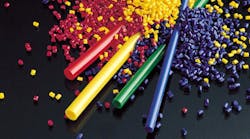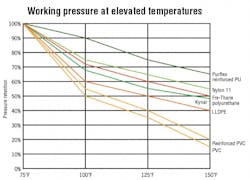Typical materials for thermoplastic tubing commonly used in pneumatic and industrial applications include nylon, polyethylene, polyurethane, and polyvinyl chloride (PVC). And manufacturers produce many variations of these basic compounds to fit specific needs, as well as products for special uses ranging from air brakes and welding operations to food and medical-grade applications.
Each thermoplastic has different characteristics that engineers need to consider when specifying tubing for a system. A familiarity with some of the different features, advantages, and shortcomings of each compound is essential in the selection process. Here are seven basic factors to consider to help pin down the tubing that best suits a job.
Pressure and temperature
Manufacturers determine the pressure rating of thermoplastic tubing by measuring the short-term burst pressure at 75°F. Working pressure is then calculated as a ratio by dividing the burst pressure by an appropriate safety factor. A 3-to-1 or 4-to-1 safety factor is commonly used, depending on the severity of the application. For example, if tubing burst pressure is 450 psi at 75°F, the working pressure with a 4-to-1 safety factor would be 112 psi. Safety factors less than 3-to-1 are not recommended.
Temperature has a definite impact upon the burst and working pressures of thermoplastic tubing. Careful consideration should be given when operating at elevated temperatures, especially temperatures approaching the maximum limits of the particular tubing compound. For instance, one typical polyurethane tube with 0.25-in. OD and 0.062-in. wall thickness has a working pressure of 265 psi at 75°F. But working pressure for the same tube drops to 105 psi at 150°F. Note that reinforced tubing can offer significantly higher pressure ratings.
Exposure to different fluids
Ensuring that the tubing resists any chemicals to which it is exposed is essential for reliable performance and long life. The best advice is to thoroughly understand the chemical resistance of your tubing material, and to always test it under real-world conditions before releasing it for use in the field.
For pneumatic applications, oil from lubricators can, over time, attack some compounds. And keep in mind any corrosives the tubing exterior may be exposed to, whether solid, liquid, or gas. In rare instances, it’s possible that the compressor could ingest materials that attack the tubing ID. With industrial fluid-handling applications, it’s usually the material the tubing conveys that is of prime concern.
A good starting point is a chemical-resistance chart which many manufacturers provide. However, be aware that the information typically comes from chemical suppliers and secondary sources. It should be used only as a general reference guide to aid in narrowing the range of potentially suitable products when chemical and material compatibility issues are a concern. That is because temperature, environmental conditions, and the presence of other chemicals can greatly affect a tubing materials’ chemical resistance.
Ultimately, the consumer must determine chemical compatibility based on the conditions in which the product will be used. But many tubing suppliers offer samples whenever possible, to assist with in-house testing.
Fittings
Three basic types of fitting are used on thermoplastic tubing: barbed fittings, compression fittings, and instant fittings (also called “push-to-connect” or “pushin” fittings). Each fitting offers different features and attributes. Considerations for the designer might include factors such as cost, pressure-holding capability, weight, corrosion resistance, durability, asthetics, and ease of installation.
But most important is that the tubing selected is compatible with the type of installed fitting. Not every fitting design is suitable for every type of tubing. In general, follow the tubing manufacturer’s guidelines, or check with the company’s applications engineers.
Physical properties and regulatory requirements
Four of the most common physical properties to consider in the tubing selection process are flexibility, kink resistance, clarity, and color. While the latter two are straightforward, the best way to fully understand differences in flexibility and kink resistance is to compare samples.
In some applications, the tubing is required to comply with a regulation or standard. Some of the more common compliance agencies that set these rules include:
• Food and Drug Administration
• National Sanitation Foundation
• U.S. Pharmaceutical (USP) Class VI
• U.S. Dept. of Agriculture
• Underwriters Laboratory
Some regulations are very general, while others are quite specific. Due to the complexity of many requirements, experts strongly recommend that system designers consult with a reputable manufacturer's technical service engineers for guidance on the exact application. But note that responsibility for compliance generally falls to the equipment builder or user.
Resistance to attack
This broad category of tubing characteristics deals mostly with exposure to environmental or working conditions. Besides the usual resistance to chemicals discussed above, some other considerations include: abrasion, moisture, flammability, kinking, vermin, ultraviolet light, bacteria, and fungus.
Often overlooked, these environmental factors can contribute to premature tubing failure. If the application has the potential to cause severe damage or injury in the event of a failure, careful selection and stringent testing are mandatory.
Cost
If more than one tubing compound will adequately serve the application, then tubing costs will factor into the decision. But the cost of a premature and unanticipated failure — in terms of damage to equipment, harm to personnel, loss of production, and maintenance time and expense — will almost always greatly outweigh the price of the tubing. Tubing is a relatively low-cost item, and its true value is found in long and trouble-free service life.
For more information on Coilhose plastic tubing, visit www.coilhose.com. For more info on Freelin-Wade, visit www.freelin-wade.com.



